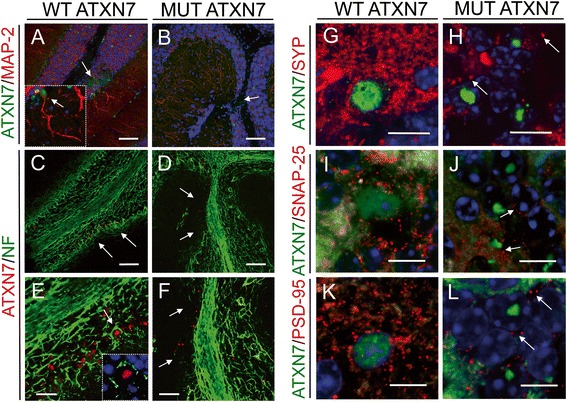Fig. 3.

MUT ATXN7 disrupts cerebellar axonal and dendritic structure and causes synaptotoxicity. Laser confocal microscopy showing loss of microtubule associated protein 2 (MAP-2) immunoreactivity (red) in the molecular layer, in cerebellar regions injected with LV-MUT-ATXN7 (green) (b); in regions transduced with WT ATXN7, MAP-2-positive arborizations were preserved (a); high magnification inset: WT ATXN7 immunoreactivity (green) in the nucleus of PCs with standard MAP-2 immunoreactivity (red) (A). Loss of NF70-kDa (NF: neurofilament) immunoreactivity (green) around the injection site was observed when MUT ATXN7 (red) was overexpressed in cerebellum (d) and (f). The standard pattern of neurofilaments (NF) immunoreactivity around PCs and in the GCL was observed in regions (arrows) transduced with WT ATXN7 (c) and (e); high magnification inset: WT ATXN7 immunoreactivity (red) in PC nuclei with standard NF-immunoreactivity (green) around PCs. Loss of synaptophysin (SYP) (red) (h), synaptosomal-associated protein 25 (SNAP-25) (red) (j) and postsynaptic density protein 95 (PSD-95) (red) (l) immunoreactivity in MUT ATXN7-transduced regions (green) (GCL); standard dot-like SYP, SNAP-25 and PSD-95 immunoreactivity was observed in WT ATXN7-expressing areas (PCs and in GCL) ((g), (i) and (k), respectively). Bars: A–D: 100 μm; E–F: 50 μm; G–L: 10 μm
